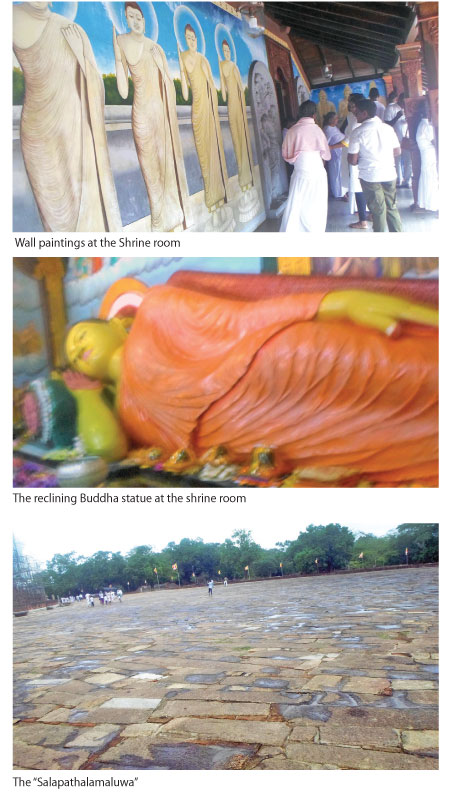Abhayagiriya was a major monastery site of Theravada, Mahayana and Vajirayana Buddhism. The monastery in Anuradhapura was built by King Wattagamini Abhaya (89- 77 B.C. popularly known as Walagamba.
Proof has been found that a Jaina temple had existed on this land in the 5th century B,C, during the rule of King Pandukabhaya (437-367 B.C.)
In 104 B.C., the youngest son of King Saddhatissa (137-119 B,C,), Prince Wattagamini Abhaya came to the throne in Anuradhapura. Soon after a Tamil invasion took place. The new king unable to withstand the attack was retreating the capital. At this time a Jaina bhikkhu was residing in the area where Abhayagiriya stands today. When the king was passing this area, the Jaina bhikkhu named Giri had shouted this way insulting the king; Maha Kalu Sinhalaya Pala Yai (The big black Sinhalese is fleeing).
The king ignored this comment but when he came back to Anuradhapura after 14 years after defeating the invaders he had not forgotten the insult.
Massive stupa
The king razed this hermitage to the ground and built a massive stupa and 12 buildings and offered it to Ven. Kuppikala Mahatissa Thera who had helped the king when he was hidden in the forest.
 According to the famous Chinese travelling bhikkhu Fa-Hien, there had been over 5,000 bhikkus residing at Abhayagiri Vihara in the 5th century. He had described the stupa as being covered with gold and jewels when he visited it in 412 BC.
According to the famous Chinese travelling bhikkhu Fa-Hien, there had been over 5,000 bhikkus residing at Abhayagiri Vihara in the 5th century. He had described the stupa as being covered with gold and jewels when he visited it in 412 BC.
The stupa was named by coining the two rivals’ names Abhaya (the king’s name) and Giri (Jaina the bhikkhu’s name).
The stupa is also believed to have been built by the same king.
The circumference of the Dagaba may be roughly put down as 1,150 feet and the original height was 400 feet. The gigantic solid work of bricks had been plastered with a thick coating of white lime mortar. There were still parts of the plaster to be seen over the Dagoba at certain spots.
Rampart
This dagaba has an extensive salapathalamaluwa (a compound paved with stone slabs) which is 600 feet by 600 feet. This raised ground laid with slabs is enclosed by a half wall on all the sides. There had been a rampart around the Welimaluwa that adjoins the platform and the width of this compound is 50 feet.
There are four entrances where guard houses had been put up through which the pilgrims and visitors had to gain admission into the sacred premises.
According to the chronicle Mahawamsa, the Buddha visited a place called Seela Chetiya in Anuradhapura on his third visit to Sri Lanka. Deepawamsa connects the Seela Chetiya and Abhayagiriya together. According to the records of Fa-Hein, the stupa of Abhayagiriya is built upon a footprint of the Buddha. Therefore, it is believed by some that the Seela Chetiya has been located where the Abhayagiri stupa stands.
Thus, this site lies on the 13th position of Solosmasthana, the sixteen Buddhist sacred sites hallowed by the Buddha and also one of the Atamastanas, one of the eight most sacred sites of Anuradhapura.









